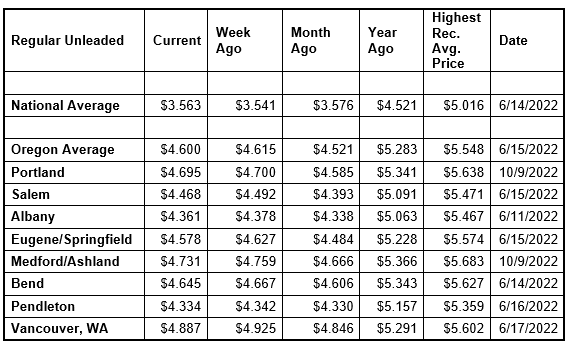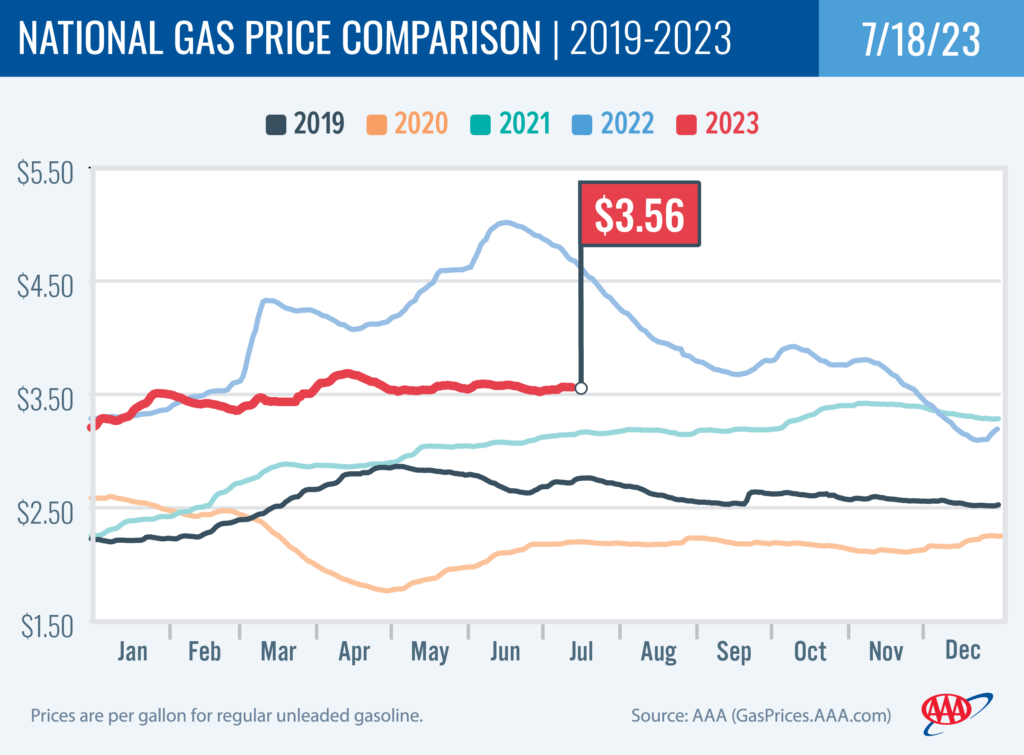PORTLAND, Ore., – The national average for regular is edging up this week, due mostly to higher crude oil prices. Crude oil climbed above $76 per barrel last week, the highest price since April. But lower demand is keeping gas price hikes in check, and 16 states, including Oregon, are seeing small declines. For the week, the national average rises two cents to $3.56. The Oregon average dips 1.5 cents to $4.60.

“Crude oil prices have risen from the upper $60s per barrel to the mid-$70s. Demand for gas in the U.S. has dropped nearly 10 percent since the 4th of July holiday. Normally such a drop would put downward pressure on pump prices, but the higher cost of crude oil is basically canceling that out,” says Marie Dodds, public affairs director for AAA Oregon/Idaho.
Crude oil prices climbed to nearly $77 per barrel last week, today, the highest price since April 25. West Texas Intermediate had been in the upper $60 to low $70 range for weeks. Oil prices were boosted on concerns of tight supplies for the rest of 2023.
Crude oil is trading around $75 today compared to $75 a week ago and $102 a year ago. In June, West Texas Intermediate ranged between about $67 and $73 per barrel. In May, WTI ranged between about $63 and $77 per barrel. In April, WTI ranged between about $73 and $83. In March, WTI ranged between about $64 and $81 per barrel. In February, WTI ranged between about $73 and $80 per barrel. In January, WTI ranged between about $73 and $82 bbl. Crude reached recent highs of $123.70 on March 8, 2022, shortly after the Russian invasion of Ukraine, and $122.11 per barrel on June 8, 2022. The all-time high for WTI crude oil is $147.27 in July 2008.
Crude oil is the main ingredient in gasoline and diesel, so pump prices are impacted by crude prices on the global markets. On average, about 56% of what we pay for in a gallon of gasoline is for the price of crude oil, 20% is refining, 11% distribution and marketing, and 14% are taxes, according to the U.S. Energy Information Administration.
Demand for gasoline decreased significantly last week as people returned to their normal driving habits after the Independence Day holiday. The U.S. Energy Information Administration (EIA) says demand fell from 9.6 to 8.76 million b/d for the week ending July 7. This compares to 8.06 million b/d a year ago. Meanwhile, total domestic gasoline stocks stayed flat at 219.5 million bbl. Although lower gas demand typically pushes pump prices lower, rising oil prices have lifted them. If oil prices continue to rise, pump prices will likely follow suit.
Quick stats
Oregon is one of 16 states and the District of Columbia with lower prices now than a week ago. Indiana (+22 cents) has the largest weekly jump. Florida (-7 cents) has the largest weekly decrease. The averages in Connecticut and Massachusetts are flat.
Washington ($4.94) has the most expensive gas in the nation for the fifth week in a row. California ($4.91) is second, Hawaii ($4.69) is third, Oregon ($4.60) is fourth, Alaska ($4.29) is fifth, and Nevada ($4.23) is sixth. These are the six states with averages at or above $4 a gallon, same as a week ago. This week 44 states and the District of Columbia have averages in the $3-range. No state has an average in the $2 range this week.
The cheapest gas in the nation is in Mississippi ($3.01) and Alabama ($3.13). For the 131st week in a row, no state has an average below $2 a gallon.
The difference between the most expensive and least expensive states is $1.92 this week, compared to $1.98 a week ago.
Oregon is one of 29 states with higher prices now than a month ago. The national average is one cent less and the Oregon average is eight cents more than a month ago. Colorado (+28 cents) and Alaska (+23 cents) have the largest monthly jumps. Arizona (-36 cents) has the largest monthly drop.
All 50 states and the District of Columbia have lower prices now than a year ago. The national average is 96 cents less and the Oregon average is 68 cents less than a year ago. West Virginia (-$1.24) has the largest yearly drop. Washington (-30 cents) has the smallest. Last year, crude oil prices and pump prices rose rapidly after the Russian invasion of Ukraine.
West Coast
The West Coast region continues to have the most expensive pump prices in the nation with six of the seven states in the top 10. It’s typical for the West Coast to have six or seven states in the top 10 as this region tends to consistently have fairly tight supplies, consuming about as much gasoline as is produced. In addition, this region is located relatively far from parts of the country where oil drilling, production and refining occurs, so transportation costs are higher. And environmental programs in this region add to the cost of production, storage and distribution.
| Rank | Region | Price on 7/11/23 |
| 1 | Washington | $4.94 |
| 2 | California | $4.91 |
| 3 | Hawaii | $4.69 |
| 4 | Oregon | $4.60 |
| 5 | Alaska | $4.29 |
| 6 | Nevada | $4.23 |
| 7 | Idaho | $3.89 |
| 8 | Utah | $3.87 |
| 9 | Illinois | $3.83 |
| 10 | Colorado | $3.83 |
As mentioned above, Washington has the most expensive gas in the nation for the fifth week in a row. California, Hawaii, Oregon, Alaska, and Nevada round out the top six. Arizona is 11th. Oregon is fourth for the sixth week in a row.
States in the West Coast region are seeing minimal movement in gas prices this week: California (+2 cents), Washington (-2 cents), Hawaii (-2 cents), Arizona (+2 cents), Oregon (-1.5 cents), and Nevada (-1 cent).
The refinery utilization rate on the West Coast rose from 91.7% to 96.7% for the week ending July 7. This rate has ranged between about 73% to 96% in the last year. The latest national refinery utilization rate is 93.7%.
According to EIA’s latest weekly report, total gas stocks in the region increased from 27.90 million bbl.to 29.28 million bbl.
A higher refinery utilization rate and an increase in gasoline stocks can put downward pressure on pump prices.
Oil market dynamics
Crude oil prices increased last week due to rising market optimism that fewer interest rate hikes may be on the horizon. This follows the release of the U.S. Consumer Price Index (CPI) report, which saw a smaller-than-expected increase in June. Before the release of the CPI, the market had been concerned that more interest rate increases could tip the economy into a recession. If a recession occurs, oil demand and prices will likely decline. Additionally, the EIA reported that total domestic commercial crude inventories increased by 5.9 million bbl to 458.1 million bbl.
At the close of Friday’s formal trading session, WTI fell $1.47 to settle at $75.42. At the close of Monday’s formal trading session, WTI lost $1.27 to settle at $74.15. Today crude is trading around $75, compared to $75 a week ago. Crude prices are about $23 less than a year ago.
Drivers can find current gas prices along their route with the free AAA Mobile app for iPhone, iPad and Android. The app can also be used to map a route, find discounts, book a hotel and access AAA roadside assistance. Learn more at AAA.com/mobile.

Diesel
For the week, the national average adds a penny to $3.86 a gallon. The record high is $5.816 set on June 19, 2022. The Oregon average slips a penny to $4.42. The record high is $6.47 set on July 3, 2022. A year ago the national average for diesel was $5.54 and the Oregon average was $6.34.
Find current fuel prices at GasPrices.AAA.com.
AAA news releases, high resolution images, broadcast-quality video, fact sheets and podcasts are available on the AAA NewsRoom at NewsRoom.AAA.com.
Find local news releases at https://oregon.aaa.com/community/media/media-contacts.html
Fuel prices are updated daily at AAA’s Daily Fuel Gauge at AAA Gas Prices. For more info go www.AAA.com. AAA Oregon/Idaho provides more than 880,000 members with travel, insurance, financial and automotive-related services, and is an affiliate of AAA National, serving more than 63 million motorists in North America.

